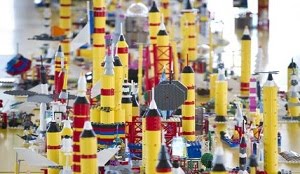Hardware for the Ares I-X flight test rocket is prepared for stacking in NASA's Vehicle Assembly Building at Kennedy Space Center in Florida. The Ares I-X is meant to test components for NASA's next-generation launch vehicle. The flights of stairs at right provide a sense of scale.
When the Soviet Union was beating America’s pants off heaving cosmonauts into orbit, a young president named John Fitzgerald Kennedy called a handful of top space experts in and decided Americans would walk on the moon.
Kennedy wanted to win the space race with the Russians — but more importantly, it was his dream to send astronauts to the moon. They needed to go because Earth is finite, a cradle for humans, and if humans are to survive they need homes out there.
America won that space race, and eventually the Cold War as well. Now another young president is facing a choice in space, and his decision could be as momentous as the one Kennedy made more than four decades ago.
Barack Obama’s decision will set the course for the nation’s space effort, just as Kennedy's decision did. The moon is the focus now, just as it was back then, and for much the same reason. If astronauts are going to make humanity’s giant leap to other worlds, it only makes sense to start with our nearest celestial neighbor.President Kennedy's Apollo program was a smashing success: Twenty-four astronauts went to the moon. Some of them went twice. They sped through the 240,000 miles of vacuum between Earth and the moon, and 12 of them descended from lunar orbit and walked and rode moon buggies across dry seas.
Kennedy didn’t live to see any of that. An assassin shot him in 1963, and the man in the White House for the Apollo landings was Richard Nixon. Not a dreamer. A man who fretted over such things as budgets and taxes — things that killed the spirit and shut the door on the future. Visionaries could not understand why we had gone to the moon and not stayed. It surely could not have been the lack of money.
A trusted network news anchor, Walter Cronkite pointed out a clear fact. “One cannot spend a dime on the moon. There isn’t a single Burger King up there.”
Uncle Walter, as he was fondly called, knew that the $24.9 billion spent on the moon program stayed on Earth. The effort employed 400,000 directly, and another 1.6 million indirectly. Two million Americans oiled Apollo’s gears and rewrote the books on medicine, communications, engineering, astronomy and hundreds of other sciences and disciplines.
But the non-dreamers were having none of it. Many in the White House thought flying through space was little more than a stunt. The war in Southeast Asia sapped resources. Nixon told America’s astronauts they could still fly — but not too far.
Birth of the shuttle
He told NASA to build a rocket machine, a cheap one that would prove to be dangerous. The spaceship was latched to a giant tank loaded with 500,000 gallons of temperamental, explosive rocket fuel — a tank with a foam skin that shed, sometimes ripping holes in the spaceship's wings. Government skinflints told astronauts that America could not afford an emergency escape system. They were not given a way to save themselves, and they were anchored in low Earth orbit for 37 years. Fourteen of their number were killed.
But in spite of the dangers and a miserly government, space shuttle astronauts flew great missions, giving Earth the magnificent Hubble Space Telescope while building an international space station that is today teaching humans how to live in hard vacuum.
Three decades would pass before another president would see the dangers and inadequacies of the space shuttle. The board investigating the Columbia accident said, "Ground them." It said emphatically that crew safety must be NASA's top priority.
George W. Bush agreed and instantly recognized the need to return to simplicity and safety, to build a flexible space fleet that could safely fly astronauts to the space station, back to the moon, on to Mars — possibly other planets, and even the asteroid belt.
Debating NASA’s next rocket
President Bush gathered the best minds and experts of the day and told them to get started.
“It’ll be cheaper to modify an unmanned rocket like the Atlas 5 or Delta 4,” said one.
“Right,” agreed another, but they soon found the Atlas 5 and the Delta 4 didn’t have the power. They would have to be beefed up.
It was back to the drawing board, and the drawing board kept pointing them back to Apollo, to the kind of system the Russians had been flying successfully for five decades.
First they would need the safest hardware out there. They would need to build a rocket that would fly only astronauts. They had had it with the “one rocket fits all” boys, and they studied and tested, and studied and tested again. And they came up with a beauty. The first stage would be made from the space shuttle’s solid rocket boosters.
Then, they needed a second stage. Again, back to Apollo — the magnificent J-2 engine.
“Must have an astronaut escape system,” one insisted. “Can’t have another Challenger.”
“Got it,” assured another, pointing to the drawing of a rocket escape tower. “This baby’s computer will boost the living to safety in a microsecond — do it from the moment of ignition.”
“Must fly a low trajectory so the crew can survive anywhere along the way,” offered a third.
“Right. Low profile all the way out.”
“Delta 4 and Atlas 5 can’t do that. Right?”
“Right. Their flight profiles are too high.”
“This has got to be the safest rocket ever flown.”
“How about 1-in-3,000 odds?”
“Great. The space shuttle is about 1 in 75, right?
“Or less.”
“And Delta 4 and Atlas 5?”
“About a third, if that.”
It was obvious that the new rocket design, dubbed the Ares I, was the safe way to go for putting humans into orbit. The master planners realized they would also need a heavy-lift monster — a rocket bigger than Apollo’s Saturn V.
Again, they reached for proven hardware. This rocket, called the Ares V, would haul record-setting loads into Earth orbit. There, astronauts would pick them up for trips most anywhere in the solar system.
The Ares V would use much of the same hardware as the Ares I. That would cost Americans $14.1 billion to $16.6 billion less than developing a heavy-lift rocket based on the Delta 4 or Atlas 5, NASA's accountants say.
NASA named the project Constellation. Along with the Ares rockets, the project calls for building a manned spacecraft called Orion and a lunar lander called Altair.
The Constellation space system is simple. It would be 45 times safer than the space shuttle, and three times safer than any modified rocket in use today. It’s a system that could serve America for most of the upcoming century.
What worries this spaceflight vet is that history might be repeating itself. My nightmares are rerunning the Apollo 1 fire.
When America’s young job corps came to this virgin spaceport, their average age was 27. They knew very little about launching astronauts into orbit, let alone sending them to the moon.
Dutifully and carefully they learned. During the Mercury and Gemini projects, these pioneers sent Alan Shepard, John Glenn, Neil Armstrong and 23 other astronauts into space.
But when these trained-on-the-job workers had logged a solid five years of experience, Apollo stepped to the plate, and all that know-how was tossed aside for the sake of political reward. The contract for Project Apollo was given to North American Aviation — a great aircraft company, but with no spaceflight experience.






0 comments:
Post a Comment